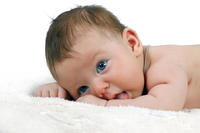Febrile convulsions
The growing brains of small children are more sensitive to fever than more mature brains and when the normal brain activity is upset a convulsion or 'fit' can occur. Febrile convulsions are common and approximately three per cent of children aged six months to six years may have a convulsion when they have a high temperature. Thirty percent of children who have a febrile convulsion will have another episode.
Most children have a body temperature around 37º Celsius. You can take a child's temperature by placing the bulb of the thermometer under their armpit for three minutes with the arm held against their side.
The seizure affects not only the child, but also parents and bystanders who may not have observed this phenomenon before. As a first aid provider, it is part of your responsibility to reassure the witnesses. The greatest fear parents have is that the child is not breathing and they think that death is imminent.
 Sign and symptoms:
Sign and symptoms:
- Previous history of infection
- Child is usually quiet and appears sick
- Flushed, hot skin
- Eyes 'roll back'
- Have difficulty breathing
- Display jerking or twitching movements
- May become stiff or floppy
- Child begins convulsing
- Salivary drool
- May become 'blue'
- After one to three minutes, child begins breathing normally
- Recovers, starts crying
- Become unconscious or unaware of their surroundings
Care and treatment:
- For child
- Remain calm
- Protect child from harm
- Place something soft under head
- Loosen tight clothing
- Roll into recovery position when jerking stops or immediately if vomited
- Reassure until fully recovered
- Remove any excessive clothing
- On recovery, assess child's breathing - if not breathing normally - give CPR
- Do not put anything in the child's mouth
- Do not restrain the child
For parents/bystanders:
- Reassure
- Arrange to see the local doctor/general practitioner after the convulsion has stopped
Discourage removal of child by persons other than ambulance personnel or trained medical assistance
When to call for an ambulance
- The seizure lasts longer than 5 minutes
- Another seizure follows quickly
- The child has difficulty breathing
- The child looks particularly unwell
Facial injuries
Facial injuries require special attention because they can damage several of the 'senses', the airway and possibly result in permanent disfigurement. Contusions, lacerations and puncture wounds can permanently disfigure the casualty. In the case of the cheek and chin, injuries also may result in loss of function if facial nerves or muscles are injured.
Ear injuries
The ear has two functions; as the receptacle of the auditory senses (hearing) and as the organ of balance. Injuries to the ear usually affect hearing function rather than balance Children are especially at risk of ear damage by inserting small objects into the ear canal.
This can have serious effects on the tympanic membrane or 'eardrum'. An old, but sensible, saying is 'nothing smaller than the elbow should be poked in the ear'. The eardrum is easily damaged. Holes or tears may be caused by swimming and diving beneath the surface, change in altitude (flying) or by vigorous nose-blowing when 'stuffed up' with a cold or flu. Minor eardrum injuries usually spontaneously repair themselves over a period of hours.
Care and treatment:
Ear obstruction
- If an insect, attempt to float it out with warm water or clean light vegetable oil
- If immovable object, seek medical aid
Ruptured eardrum:
- Place cover over affected ear to guard against infection
- Seek medical aid
Avoid using ear drops unless directed by a doctor.
Avoid swimming or water sports.
Do not poke anything into the ear.
Eye injuries
The eye is a robust but delicate organ. It can sustain quite severe damage and with the proper treatment, recover to its former state. In some instances, however, a seemingly 'minor' injury can be permanently disabling. Always consider preventing eye injuries and taking sufficient protective measures (such as protective glasses or goggles).
Generally, eye injuries are considered as either minor or major injuries.
Minor eye injuries:
These are injuries where the eye has come in contact with a foreign object causing minor irritation or the object remains on the surface of the eye. It is characterised by a bloodshot eye, irritation and an urge to rub the eye.
Care and treatment:
- Irrigate the eye and wash the object out
- If this fails, touch the corner of a clean wet cloth to the object and lift it off the surface
- Refer to medical aid if vision is affected
- Cover the affected eye if appropriate
Avoid 'pushing' the object around the eye's surface.
Only use eye-drops if prescribed by a doctor
Major eye injuries
These are injuries that involve the penetration of the body of the eye or involve severe blunt trauma to the eye. These injuries are characterised by blood in the eye, penetrating objects, and disturbance of vision, protrusion of eye contents and severe pain and spasms. Casualty care in this case is critical and should be left to the experts.
Care and treatment:
- Lay the casualty flat with complete rest
- Call Triple Zero (000) for an ambulance
- Cover the affected eye (If tolerated by the casualty, cover the unaffected eye, but remove it if the casualty becomes anxious)
- Reassurance
Eye-drops are not to be used under any circumstances